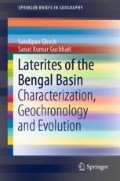Abstract
There are marked similarities in between laterites of India and Australia because these continents have moved from polar to tropical palaeolatitudes over the past 80 million years. On the basis of palaeolatitudes and laterite magnetizations, the favourable optimum climate of laterite formation was prevailed in India from Late Cretaceous to Late Tertiary. Consequently, the laterites in the northern peninsula should be older than those in the south as per drifting of the Indian plate. In this chapter, the age determination, span of lateritization event, and dating data analysis are included to draw significant information about the geochronology of laterites.
This chapter is reproduced in part from Ghosh and Guchhait (2019).
Access this chapter
Tax calculation will be finalised at checkout
Purchases are for personal use only
References
Alam M, Alam MM, Curray JR, Chowdhary MLR, Gandhi MR (2003) An overview of the sediment geology of the Bengal Basin in relation to the regional tectonic framework and basin-fill history. Sediment Geol 155(3–4):179–208
Beauvais A, Bonnet NJ, Chardon D, Arnaud N, Jayananda (2016) Very long-term stability of passive margin escarpment constrained by 40Ar/39Ar darting of K-Mn oxides. The Geological Society of America. https://doi.org/10.1130/g373031.1
Bird MI, Chivas AR (1993) Geomorphic and palaeoclimatic implications of an oxygen—isotope chronology for Australian deeply weathered profiles. Aust J Earth Sci 40(4):345–358
Bonnet NJ, Beauvais A, Arnaud N, Chardon D, Jayananda M (2014) First 40Ar/39Ar dating of intense Late Palaeogene lateritic weathering in peninsular India. Earth Planet Sci Lett 386:126–137
Bonnet N, Arnaud N, Beauvais A, Chardon D (2015a) Deciphering post-Deccan weathering and erosion history of south India Archean rocks from cryptomelane 40Ar – 39Ar dating. Geophys Res Abstr 17:9114
Bonnet N, Beauvais A, Chardon D, Arnaud N (2015b) Evolution of the south-west Indian continental divergent margin: constraints from 40Ar – 39Ar dating of lateritic paleolandsurfaces. Geophys Res Abstr 17:9377
Bourman RP (1993) Perennial problems in the study of laterite: a review. Aust J Earth Sci 40(4):387–401
Chakraborti S (2011) Final report on Quaternary laterites in the western districts of West Bengal—their geomorphology, stratigraphy, genesis and implications for climate change. Geological Survey of India Eastern Region, Kolkata, pp 1–88
Ghosh S (2014) Palaeogeographic significance of ferruginous gravel lithofacies in the Ajay-Damodar Interfluve, West Bengal, India. Int J Geol Earth Environ Sci 4(3):81–100
Ghosh S, Guchhait SK (2019) Modes of formation, Palaeogene to Early Quaternary Palaeogenesis and geochronology of laterites in Rajmahal Basalt Traps and Rarh Bengal of Lower Ganga Basin. In: Das BC, Ghosh S, Islam A (eds) Quaternary geomorphology in India. Springer, Singapore, pp 25–60
Kent RW, Pringle MS, Muller RD, Saunders AD, Ghose NC (2002) 40Ar/39Ar geochronology of the Rajmahal Basalts, India and their relationship to the Kerguelen Plateau. J Petrol 43(7):1141–1153
Kumar A (1986) Palaeolatitudes and the age of Indian laterites. Palaeogeogr Palaeoclimatol Palaeoecol 53:231–237
Meshram RR, Randive KR (2011) Geochemical study of laterites of the Jamnagar district, Gujarat, India: implications on parent rock, mineralogy and tectonics. J Asian Earth Sci 42:1271–1287
Mishra S, Deo S, Rajaguru SN (2007) Some observations on the laterites developed on Deccan Trap: implications for the Post-Deccan Trap denudational history. J Geol Soc India 70:469–475
Niyogi D (1975) Quaternary geology of the coastal plain in West Bengal and Orissa. Indian J Earth Sci 2:51–61
Niyogi D, Mallick S, Sarkar SK (1970) A preliminary study of laterites of West Bengal, India. In: Chatterjee SP, Das Gupta SP (eds) Selected papers physical geography (vol 1). 21st international geographical congress, Calcutta, National Committee for Geography, pp 443–449
Ollier CD (1988) The regolith in Australia. Earth Sci Rev 25:355–361
Rajaguru SN, Deo SG, Mishra S, Ghate S, Naik S, Shirvalkar P (2004) Geoarchaeological significance of the detrital laterites discovery in the Karha Basin, Pune District, Maharastra. Man Environ XXIX(1):1–6
Retallack GJ (2010) Lateritization and bauxitization events. Econ Geol 105:655–667
Sankaran AV, Nambi KSV, Sunta CM (1985) Thermoluminescence of laterites: applicability in dating. Nucl Tracks 17(5):177–183
Schmidt PW, Currey Ollier CD (1976) Sub-basaltic weathering, damsites, palaeomagnetism and the age of lateritization. J Geol Soc Aust 23(4):367–370
Schmidt PW, Prasad V, Raman PK (1983) Magnetic ages of some Indian laterites. Palaeogeogr Palaeoclimatol Palaeoecol 44:185–202
Singh LP, Parkash B, Singhvi AK (1998) Evolution of the Lower Gangetic Plain landforms and soils in West Bengal, India. CATENA 33:75–104
Sychanthavong SPH, Patel PK (1987) Laterites and lignites of northwestern India and their relevance to the drift tectonics of the Indian Plate. Curr Sci 56(10):469–473
Tardy Y, Kobilsex B, Paquet H (1991) Mineralogical composition of geographical distribution of African and Brazilian peri-Atlantic laterites: the influence of continental drift and tropical paleoclimates during the past 150 million years and implications for India and Australia. J Afr Earth Sci 12(1–2):283–295
Vaidyanadhan R, Ghosh RN (1993) Quaternary of the east coast of India. Curr Sci 31(6):231–232
Widdowson M, Cox KG (1996) Uplift and erosional history of the Deccan Traps, India: evidence from laterites and drainage patterns of the Western Ghats and Kankan Coast. Earth Planet Sci Lett 137:57–69
Author information
Authors and Affiliations
Corresponding author
Rights and permissions
Copyright information
© 2020 The Author(s), under exclusive license to Springer Nature Switzerland AG
About this chapter
Cite this chapter
Ghosh, S., Guchhait, S.K. (2020). Geochronology of Laterites. In: Laterites of the Bengal Basin. SpringerBriefs in Geography. Springer, Cham. https://doi.org/10.1007/978-3-030-22937-5_7
Download citation
DOI: https://doi.org/10.1007/978-3-030-22937-5_7
Published:
Publisher Name: Springer, Cham
Print ISBN: 978-3-030-22936-8
Online ISBN: 978-3-030-22937-5
eBook Packages: Earth and Environmental ScienceEarth and Environmental Science (R0)

